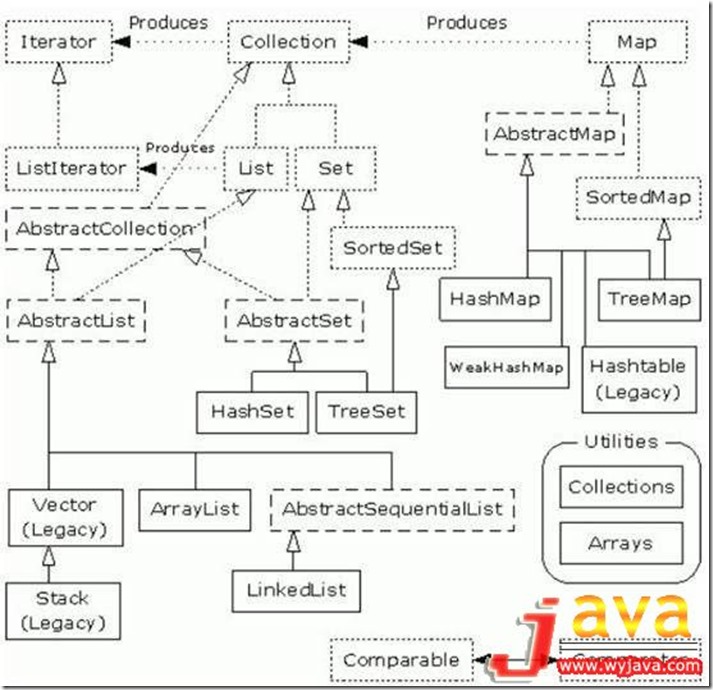数组是一种很常见的数据结构,开始接触编程的时候多数程序都和数组相关。刚开始接触Java时也是一直使用数组写一些程序,后来越来越觉得...
数组是一种很常见的数据结构,开始接触编程的时候多数程序都和数组相关。刚开始接触Java时也是一直使用数组写一些程序,后来越来越觉得数组这东西没法满足需求了,这时一位“前辈”对我说了一句:不会用集合类就等于没学过Java。然后才知道有集合类。
想想已经是3、4年前的事了,时间如白驹过隙啊。
什么时候数组会显得力不从心,没法满足需求,需要集合类呢? 不知道具体数据长度
需要自动排序
存储键值对
当然,上面的情况不是绝对的,只是数组比较难满足。这时集合类(也可称为容器类)就显示了它强大的功能。
集合类的分类

被水印遮住的单词是Comparator
上图中不包含Queue内容,部分Map的实现类未给出。
常见使用的有List、Set、Map及他们的实现类。
List、Set、Map接口及各实现类的特性
接口 特性 实现类 实现类特性 成员要求
List 线性、有序的存储容器,可通过索引访问元素 ArrayList 数组实现。非同步。
Vector 类似ArrayList,同步。
LinkedList 双向链表。非同步。
Map 保存键值对成员 HashMap 基于哈希表的Map接口的实现,满足通用需求 任意Object对象,如果修改了equals方法,需同时修改hashCode方法
TreeMap 默认根据自然顺序进行排序,或者根据创建映射时提供的 Comparator进行排序 键成员要求实现caparable接口,或者使用Comparator构造TreeMap。键成员一般为同一类型。
LinkedHashMap 类似于HashMap,但迭代遍历时取得“键值对”的顺序是其插入顺序或者最近最少使用的次序 与HashMap相同
IdentityHashMap 使用==取代equals()对“键值”进行比较的散列映射 成员通过==判断是否相等
WeakHashMap 弱键映射,允许释放映射所指向的对象
ConcurrentHashMap 线性安全的Map
Set 成员不能重复 HashSet 为快速查找设计的Set 元素必须定义hashCode()
TreeSet 保持次序的Set,底层为树结构 元素必须实现Comparable接口
LinkedHashSet 内部使用链表维护元素的顺序(插入的次序) 元素必须定义hashCode()
在满足要求的情况下,Map应尽量使用HashMap,Set应尽量使用HashSet。
集合类的基本使用
List
List基本操作
ArrayList arrayList = new ArrayList();
arrayList.add("Tom");
arrayList.add("Jerry");
arrayList.add("Micky");//使用Iterator遍历元素
Iterator it =arrayList.iterator();while(it.hasNext()) {
String str=it.next();
System.out.println(str);
}//在指定位置插入元素
arrayList.add(2, "Kate");//通过索引直接访问元素
for (int i = 0; i < arrayList.size(); i++) {
System.out.println(arrayList.get(i));
}
List subList = new ArrayList();
subList.add("Mike");//addAll(Collection extends String> c)添加所给集合中的所有元素
arrayList.addAll(subList);//判断是否包含某个元素
if (arrayList.contains("Mike")) {
System.out.println("Mike is include in the list");
}
LinkedList linkedList = new LinkedList();
linkedList.addAll(arrayList);//获取指定元素
System.out.println(linkedList.get(4));//获取第一个元素
System.out.println(linkedList.getFirst());//获取最后一个元素
System.out.println(linkedList.getLast());//获取并删除第一个元素
System.out.println(linkedList.pollFirst());//获取,但不移除第一个元素
System.out.println(linkedList.peekFirst());
ArrayList和LinkedList的效率比较
//ArrayList添加元素的效率
ArrayList arrList = new ArrayList();longstartTimeMillis, endTimeMillis;
startTimeMillis=System.currentTimeMillis();for (int i = 0; i < 10000; i++) {
arrList.add(0, "addString");
}
endTimeMillis=System.currentTimeMillis();
System.out.println("ArrayList:" + (endTimeMillis -startTimeMillis)+ "ms");
arrList.clear();
startTimeMillis=System.currentTimeMillis();for (int i = 0; i < 20000; i++) {
arrList.add(0, "addString");
}
endTimeMillis=System.currentTimeMillis();
System.out.println("ArrayList:" + (endTimeMillis -startTimeMillis)+ "ms");
arrList.clear();
startTimeMillis=System.currentTimeMillis();for (int i = 0; i < 40000; i++) {
arrList.add(0, "addString");
}
endTimeMillis=System.currentTimeMillis();
System.out.println("ArrayList:" + (endTimeMillis -startTimeMillis)+ "ms");
arrList.clear();
startTimeMillis=System.currentTimeMillis();for (int i = 0; i < 80000; i++) {
arrList.add(0, "addString");
}
endTimeMillis=System.currentTimeMillis();
System.out.println("ArrayList:" + (endTimeMillis -startTimeMillis)+ "ms");
arrList.clear();
startTimeMillis=System.currentTimeMillis();for (int i = 0; i < 160000; i++) {
arrList.add(0, "addString");
}
endTimeMillis=System.currentTimeMillis();
System.out.println("ArrayList:" + (endTimeMillis -startTimeMillis)+ "ms");
arrList.clear();
startTimeMillis=System.currentTimeMillis();for (int i = 0; i < 320000; i++) {
arrList.add(0, "addString");
}
endTimeMillis=System.currentTimeMillis();
System.out.println("ArrayList:" + (endTimeMillis -startTimeMillis)+ "ms");
执行时间比较
执行次数(在0号位置插入)
ArrayList所用时间(ms)
LinkedList所用时间(ms)
10000
31
0
20000
141
0
40000
484
16
80000
1985
0
160000
7906
0
320000
31719
16
执行次数(在尾部插入)
ArrayList所用时间(ms)
LinkedList所用时间(ms)
10000
0
0
20000
15
0
40000
0
0
80000
0
0
160000
0
15
320000
0
16
循环输出次数(get(index)方法)
ArrayList所用时间(ms)
LinkedList所用时间(ms)
10000
93
204
20000
188
797
40000
328
2734
80000
688
13328
160000
1594
62313
320000
2765
太久了……
因为ArrayList底层由数组实现,在0号位置插入时将移动list的所有元素,在末尾插入元素时不需要移动。LinkedList是双向链表,在任意位置插入元素所需时间均相同。所以在List中有较多插入和删除操作的情况下应使用LinkedList来提高效率,而有较多索引查询的时候使用 ArrayList(使用增强型的for循环或Iterator遍历LinkedList效率将提高很多)。
Map
Map基本操作
HashMap map = new HashMap();//向Map中添加元素
map.put("Tom", 26);
map.put("Jack", 18);
map.put("Micky", 17);
map.put("Kate", 15);//根据Key获取Value
System.out.println("Jack is " + map.get("Jack") + " years old");//移除
map.remove("Micky");//遍历Map
for (Entryentry : map.entrySet()) {
System.out.println("name:" + entry.getKey() + " age:"
+entry.getValue());
}//Key相同的元素将被覆盖
map.put("Jack", 19);//根据Key获取Value
System.out.println("Jack is " + map.get("Jack") + " years old");//判断是否包含某个Key
if (map.containsKey("Tom")) {
System.out.println(map.get("Tom"));
}//判断是否包含某个Value
if (map.containsValue(26)) {
System.out.println("The map include the value 26");
}//判断map是否为空
if (!map.isEmpty()) {//获取map大小
System.out.println("The map's size=" +map.size());
}//获取Key的集合
for(String str : map.keySet()) {
System.out.println(str);
}
TreeMap treeMap = new TreeMap();
treeMap.putAll(map);//输出内容按照key值排序
for (Entryentry : treeMap.entrySet()) {
System.out.println("name:" + entry.getKey() + " age:"
+entry.getValue());//name:Jack age:19//name:Kate age:15//name:Tom age:26
}
LinkedHashMap linkedHashMap = new LinkedHashMap();//向Map中添加元素
linkedHashMap.put("Tom", 26);
linkedHashMap.put("Jack", 18);
linkedHashMap.put("Micky", 17);
linkedHashMap.put("Kate", 15);//保持了插入的顺序
for (Entryentry : linkedHashMap.entrySet()) {
System.out.println("name:" + entry.getKey() + " age:"
+entry.getValue());//name:Tom age:26//name:Jack age:18//name:Micky age:17//name:Kate age:15
}
Set
Set基础操作
List list = new ArrayList();
list.add(3);
list.add(4);
HashSet hashSet = new HashSet();
hashSet.add(1);
hashSet.add(3);
hashSet.add(2);
hashSet.add(6);//重复元素将不能被添加
hashSet.add(3);//只要有元素被添加就返回true
if(hashSet.addAll(list)) {
System.out.println("Add success");
}//判断是否存在某个集合
if(hashSet.containsAll(list)) {
System.out.println("The hashSet is contain 3 and 4");
}
Iterator it =hashSet.iterator();while(it.hasNext()) {
System.out.print(it.next()+ " ");//1 2 3 4 6//看结果是被排序了,HashSet按照Hash函数排序,Integer值的HashCode就是其int值
}//换转成数组
Object[] integers =hashSet.toArray();for (int i = 0; i < integers.length; i++) {
System.out.print((Integer) integers[i]);
}//移除元素
hashSet.remove(3);
TreeSet treeSet = new TreeSet();
treeSet.add("C");
treeSet.add("A");
treeSet.add("D");
treeSet.add("B");for (Iterator strIt =treeSet.iterator(); strIt.hasNext();) {
System.out.print(strIt.next());//ABCD 按照字母顺序
}
LinkedHashSet linkedHashSet = new LinkedHashSet();
linkedHashSet.add("C");
linkedHashSet.add("A");
linkedHashSet.add("D");
linkedHashSet.add("B");for (Iterator linkedIt =linkedHashSet.iterator(); linkedIt
.hasNext();) {
System.out.print(linkedIt.next());//CADB 按照插入顺序
}
本文没有对ArrayList及HashMap进行深入的分析,这两个类是集合类中最常用的类,将另开文章进行深入剖析。